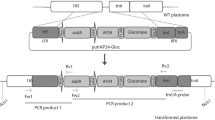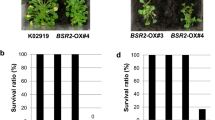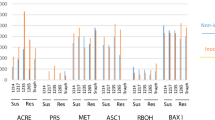Abstract
Cotton is an economically important crop worldwide that suffers severe losses due to a wide range of fungal/bacterial pathogens and nematodes. Given its susceptibility to various pathogens, it is important to obtain a broad-spectrum resistance in cotton. Resistance to several fungal and bacterial diseases has been obtained by overexpressing the Non-expressor of Pathogenesis-Related genes-1 (NPR1) in various plant species with apparently minimal or no pleiotropic effects. We examined the efficacy of this approach in cotton by constitutive expression of the Arabidopsis (Arabidopsis thaliana) NPR1 gene. The results show that NPR1-expressing lines exhibited significant resistance to Verticillium dahliae isolate TS2, Fusarium oxysporum f. sp. vasinfectum, Rhizoctonia solani, and Alternaria alternata. Interestingly, the transformants also showed significant resistance to reniform nematodes. Analysis of defense-related, biochemical and molecular responses suggest that when challenged with pathogens or certain systemic acquired resistance-inducing chemicals, the transgenic lines respond to a greater degree compared to the wild-type plants. Importantly, the basal activities of the defense-related genes and enzymes in uninduced transformants were no different than those in their non-transgenic counterparts. The results provide additional evidence supporting the role of NPR1 as an important part of the plant defense system and suggest a means to achieve broad-spectrum resistance to pathogens via genetic engineering.








Similar content being viewed by others
References
Abeles FB, Forrence LE (1970) Temporal and hormonal control of beta-1,3-glucanase in Phaseolus vulgaris L. Plant Physiol 45:395–400
Bell AA (1967) Formation of gossypol in infected or chemically irritated tissues of gossypium species. Phytopathology 57:759–764
Bell AA (1969) Phytoalexin production and Verticillium wilt resistance in cotton. Phytopathology 59:1119–1127
Bianchini GM, Stipanovic RD, Bell AA (1999) Induction of delta-cadinene synthase and sesquiterpenoid phytoalexins in cotton by Verticillium dahliae. J Agr Food Chem 47:4403–4406
Blasingame D, Bank JC, Colyer PD, Davis M, Gazaway WS, Kemerait RC, Kirkpatrick TL, Koenning SR, John Muller, Newman M, Mary Olsen, Phipps PM, Sciumbato GL, Richard Sprenke, Woodward JE, Wrather A, Patel MV (2008) Cotton disease loss estimatecommittee report. In: Procceedings of Beltwide cotton conferences. Nashville, Tennessee. Jan 2008, pp 294–297
Bolek Y, Bell AA, El-Zik KM, Thaxton PM, Magill CW (2005) Reaction of cotton cultivars and an F-2 population to stem inoculation with isolates Verticillium dahliae. J Phytopathol 153:269–273
Cao H, Bowling SA, Gordon AS, Dong X (1994) Characterization of an Arabidopsis mutant that is nonresponsive to inducers of systemic acquired resistance. Plant Cell 6:1583–1592
Cao H, Li X, Dong X (1998) Generation of broad-spectrum disease resistance by overexpression of an essential regulatory gene in systemic acquired resistance. Proc Natl Acad Sci USA 95:6531–6536
Chern MS, Fitzgerald HA, Yadav RC, Canlas PE, Dong X, Ronald PC (2001) Evidence for a disease-resistance pathway in rice similar to the NPR1-mediated signaling pathway in Arabidopsis. Plant J 27:101–113
Chern M, Fitzgerald HA, Canlas PE, Navarre DA, Ronald PC (2005) Overexpression of a rice NPR1 homolog leads to constitutive activation of defense response and hypersensitivity to light. Mol Plant-Microbe Interact 18:511–520
Chinnasri B, Sipes BS, Schmitt DP (2003) Effects of Acibenzolar-S-methyl application to Rotylenchulus reniformis and Meloidogyne javanica. J Nematol 35:110–114
Chinnasri B, Sipes BS, Schmitt DP (2006) Effects of inducers of systemic acquired resistance on reproduction of Meloidogyne javanica and Rotylenchulus reniformis in pineapple. J Nematol 38:319–325
Colson-Hanks ES, Deverall BJ (2000) Effect of 2,6-dichloroisonicotinic acid, its formulation materials and benzothiadiazole on systemic resistance to alternaria leaf spot in cotton. Plant Pathol 49:171–178
Davis RM, Colyer PD, Rothrock CS, Kochman JK (2006) Fusarium wilt of cotton: population diversity and implication for management. Plant Dis 90:692–703
Delaney TP, Friedrich L, Ryals JA (1995) Arabidopsis signal transduction mutant defective in chemically and biologically induced disease resistance. Proc Natl Acad Sci USA 92:6602–6606
Despres C, DeLong C, Glaze S, Liu E, Fobert PR (2000) The Arabidopsis NPR1/NIM1 protein enhances the DNA binding activity of a subgroup of the TGA family of bZIP transcription factors. Plant Cell 12:279–290
Djonovic S, Pozo MJ, Dangott LJ, Howell CR, Kenerley CM (2006) Sm1, a proteinaceous elicitor secreted by the biocontrol fungus Trichoderma virens induces plant defense responses and systemic resistance. Mol Plant-Microbe Interact 19:838–853
Dong XN (2004) NPR1, all things considered. Current Opin Plant Biol 7:547–552
Eldon S, Hillocks RJ (1996) The effect of reduced phytoalexin production on the resistance of upland cotton (Gossypium hirsutum) to Verticillium and Fusarium wilts. Ann Appl Biol 129:217–225
Emani C, Garcia JM, Lopata-Finch E, Pozo MJ, Uribe P, Kim DJ, Sunilkumar G, Cook DR, Kenerley CM, Rathore KS (2003) Enhanced fungal resistance in transgenic cotton expressing an endochitinase gene from Trichoderma virens. Plant Biotechnol J 1:321–336
Fan W, Dong X (2002) In vivo interaction between NPR1 and transcription factor TGA2 leads to salicylic acid-mediated gene activation in Arabidopsis. Plant Cell 14:1377–1389
Fitzgerald HA, Chern MS, Navarre R, Ronald PC (2004) Overexpression of (At)NPR1 in rice leads to a BTH- and environment-induced lesion-mimic/cell death phenotype. Mol Plant-Microbe Interact 17:140–151
Fradin EF, Thomma BPHJ (2006) Physiology and molecular aspects of Verticillium wilt diseases caused by V. dahliae and V. albo-atrum. Mol. Plant Pathol 7:71–86
Friedrich L, Lawton K, Ruess W, Masner P, Specker N, Rella MG, Meier B, Dincher S, Staub T, Uknes S, Metraux JP, Kessmann H, Ryals J (1996) A benzothiadiazole derivative induces systemic acquired resistance in tobacco. Plant J 10:61–70
Friedrich L, Lawton K, Dietrich R, Willits M, Cade R, Ryals J (2001) NIM1 overexpression in Arabidopsis potentiates plant disease resistance and results in enhanced effectiveness of fungicides. Mol Plant Microbe Interact 14:1114–1124
Gorlach J, Volrath S, Knauf-Beiter G, Hengy G, Beckhove U, Kogel KH, Oostendorp M, Staub T, Ward E, Kessmann H, Ryals J (1996) Benzothiadiazole, a novel class of inducers of systemic acquired resistance, activates gene expression and disease resistance in wheat. Plant Cell 8:629–643
Grant M, Lamb C (2006) Systemic immunity. Curr Opin Plant Biol 9:414–420
Hampton RE, Wullschleger SD, Ossterhuis DM (1990) Impact of Verticillium wilt on net photosynthesis, respiration and photorespiration in field-grown cotton (Gossypium hirsutum L.). Physiol Mol Plant Pathol 37:271–280
Hillocks RJ (1992a) Fungal diseases of the leaf. In: Hillocks RJ (ed) Cotton diseases. CAB International, Oxon, UK, pp 191–238
Hillocks RJ (1992b) Seedling diseases. In: Hillocks RJ (ed) Cotton diseases. Oxon, CAB International, pp 1–38
Hudspeth RL, Hobbs SL, Anderson DM, Grula JW (1996) Characterization and expression of chitinase and 1,3-beta-glucanase genes in cotton. Plant Mol Biol 31:911–916
Kachroo P, Yoshioka K, Shah J, Dooner HK, Klessig DF (2000) Resistance to turnip crinkle virus in Arabidopsis is regulated by two host genes and is salicylic acid dependent but NPR1, ethylene, and jasmonate independent. Plant Cell 12:677–690
Kesarwani M, Yoo J, Dong X (2007) Genetic interactions of TGA transcription factors in the regulation of pathogenesis-related genes and disease resistance in Arabidopsis. Plant Physiol 144:336–346
Kinkema M, Fan W, Dong X (2000) Nuclear localization of NPR1 is required for activation of PR gene expression. Plant Cell 12:2339–2350
Koenning SR, Kirkpatrick TL, Starr JL, Wrather JA, Walker NR, Mueller JD (2004) Plant-parasitic nematodes attacking cotton in the United States—old and emerging production challenges. Plant Dis 88:100–113
Kohler A, Schwindling S, Conrath U (2002) Benzothiadiazole-induced priming for potentiated responses to pathogen infection, wounding, and infiltration of water into leaves requires the NPR1/NIM1 gene in Arabidopsis. Plant Physiol 128:1046–1056
Kumar V, Parkhi V, Kenerley CM, Rathore KS (2009) Defense-related gene expression and enzyme activities in transgenic cotton plants expressing an endochitinase gene from Trichoderma virens in response to interaction with Rhizoctonia solani. Planta 230:277–291
Leon-Reyes A, Spoel SH, De Lange ES, Abe H, Kobayashi M, Tsuda S, Millenaar FF, Welschen RA, Ritsema T, Pieterse CM (2009) Ethylene modulates the role of NONEXPRESSOR OF PATHOGENESIS-RELATED GENES1 in cross talk between salicylate and Jasmonate signaling. Plant Physiol 149:1797–1809
Lin WC, Lu CF, Wu JW, Cheng ML, Lin YM, Yang NS, Black L, Green SK, Wang JF, Cheng CP (2004) Transgenic tomato plants expressing the Arabidopsis NPR1 gene display enhanced resistance to a spectrum of fungal and bacterial diseases. Transgenic Res 13:567–581
Mace ME (1983) Elicitation of accumulation of terpenoid aldehyde phytoalexins in Verticillium dahliae infected cotton. New Phytol 95:115–119
Mace ME, Stipanovic RD, Bell AA (1989) Histochemical localization of desoxyhemigossypol, a phytoalexin in Verticillium dahliae-infected cotton stems. New Phytol 111:229–232
Makandar R, Essig JS, Schapaugh MA, Trick HN, Shah J (2006) Genetically engineered resistance to Fusarium head blight in wheat by expression of Arabidopsis NPR1. Mol Plant Microbe Interact 19:123–129
Malnoy M, Jin Q, Borejsza-Wysocka EE, He SY, Aldwinckle HS (2007) Overexpression of the apple MpNPR1 gene confers increased disease resistance in malus x domestica. Mol Plant-Microbe Interact 20:1568–1580
Martinez C, Baccou JC, Bresson E, Baissac Y, Daniel JF, Jalloul A (2000) Salicylic acid mediated by the oxidative burst is a key molecule in local and systemic responses of cotton challenged by an avirulent race of Xanthomonas campestris pv malvacearum. Plant Physiol 122:757–766
Mauch-Mani B, Slusarenko AJ (1994) Systemic acquired resistance in Arabidopsis thaliana induced by a predisposing infection with a pathogenic isolate of Fusarium oxysporum. Mol Plant-Microbe Interact 7:378–383
Mou Z, Fan W, Dong X (2003) Inducers of plant systemic acquired resistance regulate NPR1 function through redox changes. Cell 113:935–944
Murray F, Llewellyn D, McFadden H, Last D, Dennis ES, Peacock WJ (1999) Expression of the Talaromyces flavus glucose oxidase gene in cotton and tobacco reduces fungal infection, but is also phytotoxic. Mol Breed 5:219–232
Nandi B, Kundu K, Banerjee N, Babu SPS (2003) Salicylic acid-inducedsuppression of Meloidogyne incognita infestation of okra and cowpea. Nematology 5:747–752
Nawrath C, Metraux JP (1999) Salicylic acid induction-deficient mutants of Arabidopsis express PR-2 and PR-5 and accumulate high levels of camalexin after pathogen inoculation. Plant Cell 11:1393–1404
Pieterse CM, Van Loon L (2004) NPR1: the spider in the web of induced resistance signaling pathways. Current Opin Plant Biol 7:456–464
Potlakayala SD, DeLong C, Sharpe A, Fobert PR (2007) Conservation of non-expressor of pathogenesis-related genes 1 function between Arabidopsis thaliana and Brassica napus. Physiol Mol Plant Pathol 71:174–183
Quilis J, Penas G, Messeguer J, Brugidou C, San Segundo B (2008) The Arabidopsis AtNPR1 inversely modulates defense responses against fungal, bacterial, or viral pathogens while conferring hypersensitivity to abiotic stresses in transgenic rice. Mol Plant-Microbe Interact 21:1215–1231
Rairdan GJ, Delaney TP (2002) Role of salicylic acid and NIM1/NPR1 in race-specific resistance in Arabidopsis. Genetics 161:803–811
Rajasekaran K, Cary JW, Jaynes JM, Cleveland TE (2005) Disease resistance conferred by the expression of a gene encoding a synthetic peptide in transgenic cotton (Gossypium hirsutum L.) plants. Plant Biotechnol J 3:545–554
Raskin I, Skubatz H, Tang W, Meeuse BJD (1990) Salicylic-acid levels in thermogenic and nonthermogenic plants. Ann Bot 66:369–373
Rathore KS, Sunilkumar G, Campbell LM (2006) Cotton (Gossypium hirsutum L.). Methods Mol Biol 343:267–279
Robinson AF, Heald CM (1991) Carbon-dioxide and temperature-gradients in baermann funnel extraction of Rotylenchulus-reniformis. J Nematology 23:28–38
Robinson AF, Cook CG, Percival AE (1999) Resistance to Rotylenchulus reniformis and Meloidogyne incognita race 3 in the major cotton cultivars planted since 1950. Crop Sci 39:850–858
Robinson AF, Bell AA, Dighe ND, Menz MA, Nichols PL, Stelly DM (2007) Introgression of resistance to nematode Rotylenchulus reniformis into upland cotton (Gossypium hirsutum) from Gossypium longicalyx. Crop Sci 47:1865–1877
Ryals J, Uknes S, Ward E (1994) Systemic acquired-resistance. Plant Physiol 104:1109–1112
Ryals JA, Neuenschwander UH, Willits MG, Molina A, Steiner HY, Hunt MD (1996) Systemic acquired resistance. Plant Cell 8:1809–1819
Shah J (2003) The salicylic acid loop in plant defense. Curr Opin Plant Biol 6:365–371
Shah J, Tsui F, Klessig DF (1997) Characterization of a salicylic acid-insensitive mutant (sai1) of Arabidopsis thaliana, identified in a selective screen utilizing the SA-inducible expression of the tms2 gene. Mol Plant-Microbe Interact 10:69–78
Shah J, Kachroo P, Nandi A, Klessig DF (2001) A recessive mutation in the Arabidopsis SSI2 gene confers SA- and NPR1-independent expression of PR genes and resistance against bacterial and oomycete pathogens. Plant J 25:563–574
Silverman P, Seskar M, Kanter D, Schweizer P, Metraux JP, Raskin I (1995) Salicylic acid in rice: biosynthesis, conjugation, and possible role. Plant Physiol 108:633–639
Spoel SH, Koornneef A, Claessens SMC, Korzelius JP, Van Pelt JA, Mueller MJ, Buchala AJ, Métraux JP, Brown R, Kazan K, Van Loon LC, Dong X, Pieterse CMJ (2003) NPR1 modulates cross-talk between salicylate- and jasmonate-dependent defense pathways through a novel function in the cytosol. Plant Cell 15:760–770
Spoel SH, Johnson JS, Dong X (2007) Regulation of tradeoffs between plant defenses against pathogens with different lifestyles. Proc Natl Acad Sci USA 104:18842–18847
Stipanovic RD, Bell AA, Benedict CR (1999) Cotton pest resistance: the role of pigment gland constituents. In: Cultler HG, Cultler SJ (eds) Biologically active natural products: agrochemicals. CRC Press, Boca Raton, pp 211–220
Sunilkumar G, Rathore KS (2001) Transgenic cotton: factors influencing Agrobacterium-mediated transformation and regeneration. Mol Breed 8:37–52
Tada Y, Spoel SH, Pajerowska-Mukhtar K, Mou Z, Song J, Wang C, Zuo J, Dong X (2008) Plant immunity requires conformational charges of NPR1 via S-nitrosylation and thioredoxins. Science 321:952–956
Timmermans MC, Maliga P, Vieira J, Messing J (1990) The pFF plasmids: cassettes utilising CaMV sequences for expression of foreign genes in plants. J Biotechnol 14:333–344
Uknes S, Mauch-Mani B, Moyer M, Potter S, Williams S, Dincher S, Chandler D, Slusarenko A, Ward E, Ryals J (1992) Acquired resistance in Arabidopsis. Plant Cell 4:645–656
Wally O, Jayaraj J, Punja ZK (2009) Broad-spectrum disease resistance to necrotrophic and biotrophic pathogens in transgenic carrots (Daucus carota L.) expressing an Arabidopsis NPR1 gene. Planta. doi 10.1007/s00425-009-1031-2
Wang YQ, Chen DJ, Wang DM, Huang QS, Yao ZP, Liu FJ, Wei XW, Li RJ, Zhang ZN, Sun YR (2004) Over-expression of Gastrodia anti-fungal protein enhances Verticillium wilt resistance in coloured cotton. Plant Breed 123:454–459
Ward ER, Uknes SJ, Williams SC, Dincher SS, Wiederhold DL, Alexander DC, Ahl-Goy P, Metraux JP, Ryals JA (1991) Coordinate gene activity in response to agents that induce systemic acquired resistance. Plant Cell 3:1085–1094
Wubben MJE, Jin J, Baum TJ (2008) Cyst nematode parasitism of Arabidopsis thaliana is inhibited by salicylic acid (SA) and elicits uncoupled SA-independent pathogenesis-related gene expression in roots. Mol Plant-Microbe Interact 21:424–432
Yang Y, Qi M, Mei C (2004) Endogenous salicylic acid protects rice plants from oxidative damage caused by aging as well as biotic and abiotic stress. Plant J 40:909–919
Zhou JM, Trifa Y, Silva H, Pontier D, Lam E, Shah J, Klessig DF (2000) NPR1 differentially interacts with members of the TGA/OBF family of transcription factors that bind an element of the PR-1 gene required for induction by salicylic acid. Mol Plant-Microbe Interact 13:191–202
Zhu YJ, Qiu XH, Moore PH, Borth W, Hu J, Ferreira S, Albert HH (2003) Systemic acquired resistance induced by BTH in papaya. Physiol Mol Plant Path 63:237–248
Acknowledgments
We thank Dr. Charles Kenerley for providing Rhizoctonia solani, and Alternaria alternata cultures that were used in this study. This research was supported by funds from Cotton Inc., Texas Higher Education Coordinating Board—Advanced Research Program (#000517-0005-2006), and Texas AgriLife Research.
Author information
Authors and Affiliations
Corresponding author
Electronic supplementary material
Below is the link to the electronic supplementary material.
Rights and permissions
About this article
Cite this article
Parkhi, V., Kumar, V., Campbell, L.M. et al. Resistance against various fungal pathogens and reniform nematode in transgenic cotton plants expressing Arabidopsis NPR1 . Transgenic Res 19, 959–975 (2010). https://doi.org/10.1007/s11248-010-9374-9
Received:
Accepted:
Published:
Issue Date:
DOI: https://doi.org/10.1007/s11248-010-9374-9




